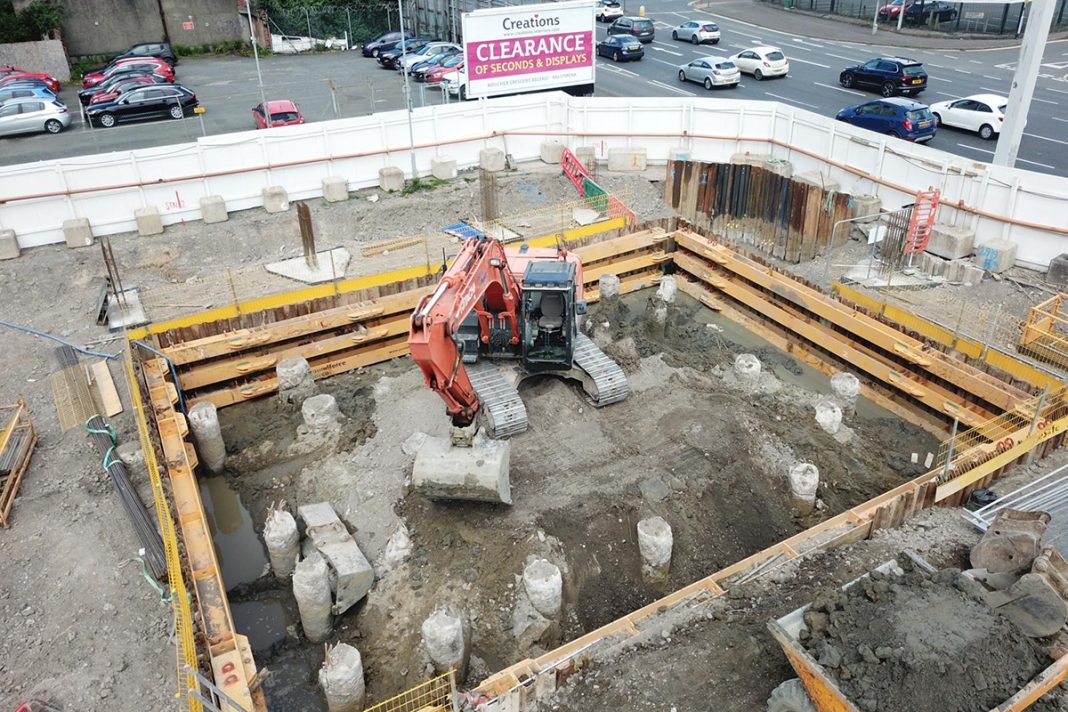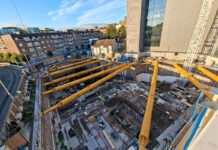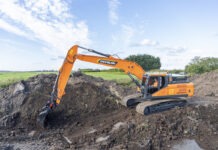Building and engineering contractors J & S McKee Ltd, who have undertaken a complete sub structure package of works on a prominent new 12-storey student accommodation development in Belfast, appointed Groundforce to provide a ground retention solution during the sub structure phases.
Called ‘Nelson Street’ and located on Belfast’s Westlink road corridor, this new 245,000ft2, purpose built managed student accommodation development is adjacent to the new University of Ulster campus. Once completed, it will provide 774 bedrooms, with shared sports and recreation facilities including a games hall, wellness room and VR sports room.
The scope of J & S McKee Ltd’s package of works included all materials and temporary works to the £60m U-shaped structure, with the multi-use recreational facilities nestled within the ‘U’ of the main building.
With a number of large, deep excavations in very poor ground, and adjacent to one of the busiest road networks in Belfast, this element of the works presented a number of interesting challenges.
J & S McKee Ltd, working closely with Groundforce’s local operations and technical teams, were able to install a ground support system to allow excavation to the depths required while maintaining access for heavy site traffic during the construction phase.
There were two stairwell/lift core bases expanding to 16m x 13m at a depth of 3.5m, two tower crane bases at 12m x 12m and 4.0m deep, and a 14m x 12m base for an NIE substation at a depth of 2.5m, with the 260m perimeter of the site also needing full retention for construction of the ground beams.
The ground conditions consisted of 1.5m of made ground overlaying 2-3m of water saturated sand, with a robust temporary works design and shoring system required to keep other site operations running smoothly and unhindered.
Due to the poor ground conditions, the sheet piled perimeter of each excavation had to be supported by a heavy-duty hydraulic framing system.
“In reasonable ground conditions a sheet pile toe can help reduce the load on the internal support system. However, due to the poor ground conditions in these locations, a sheet toe-in would have added load to the system. This occurs during the excavation phase, when the level of soft material tries to equalise, creating a moment at the end of the sheet and transferring loading into the support system,” comments Groundforce director Joe Lenihan.
Therefore a “no-toe” solution was required but with no less than three levels of frames to withstand the high loading from the saturated sand layer.
“Due to the large plan dimensions of these excavations, the capacity of frames were greatly reduced leading to the requirement for three levels of support,” says Joe Lenihan. “We explored the option of increasing the capacity of the fames by adding knee braces. However, these would have interfered with the permanent works so the three levels of frame proved preferable,” he adds.
Sean McKee, Director of J & S McKee Ltd, said: “The tricky ground conditions and depths of excavations, coupled with the proximity of the works to the site perimeters, certainly demanded respect regarding design and implementation of the Temporary Works systems. We deem this a success, with H&S, buildability, programme and cost expectations all being met. These key targets were achieved by a collaborative approach from Groundforce and J & S McKee Ltd.”
The substructure works are now complete, with the project due for completion in August 2023.








